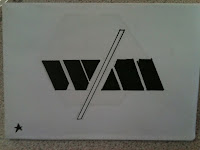For help with our ongoing brief 'what is design for print' a print visit was arrange by our year tutor.
After the visit i feel far more knowledgable about print now and wouldn't mind taking an other visit to a different warehouse just for a bit more experience.
Litho Printing.
Is a six colour printing machine that uses CMYK, and also 2 more spot colours.
- The image/images are etched onto a plate.
- 4 different plates one for each colour - C/M/Y/K.
- The plates are attached onto different sections of the machine.
- The paper is lifted using small suction pads.
- It is then fed into the print passing through each section were the ink is pressed from the plated to the rubber roller and from there onto the paper, this is because the plates would wear down easily if it was straight from the plates.
- Ink is added to each section by hand, fed into the top of the machine.
- Prints are regularly checked to make sure the registration marks are aligned properly.
- At the end of the process starch is sprayed onto the paper to stop them from sticking together (the starch is so fine you cannot see or feel it, therefore not damaging the prints).
-
Die Cutting.
Die cutting is another print method used by Target.
- The Die cutting shapes are made by hand from another company working along side target.
- The shapes are cut out by this machine pressing them onto paper.
























































